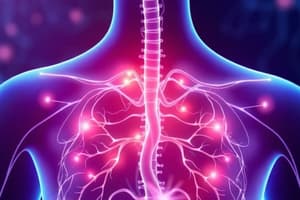Podcast
Questions and Answers
Describe the types of stimuli that activate the endocrine glands.
Describe the types of stimuli that activate the endocrine glands.
Hormonal stimuli, humoral stimuli, neural stimuli.
Define negative feedback and explain how it regulates blood levels of various hormones. Provide an example.
Define negative feedback and explain how it regulates blood levels of various hormones. Provide an example.
Negative feedback controls hormone release by triggering more hormone release in response to low levels until appropriate levels are reached. Example: Glucagon is released when blood glucose is low to raise the level until normal.
Explain the pituitary-hypothalamus relationship.
Explain the pituitary-hypothalamus relationship.
The hypothalamus controls the pituitary gland through releasing and inhibiting hormones, which are sent via the blood supply to the anterior pituitary, while also storing oxytocin and antidiuretic hormone in the posterior pituitary.
Name the two hormones closely involved in the regulation of fluid and electrolyte balance of the body and explain their effects on their common target organ.
Name the two hormones closely involved in the regulation of fluid and electrolyte balance of the body and explain their effects on their common target organ.
Flashcards are hidden until you start studying
Study Notes
Stimuli Activating Endocrine Glands
- Hormonal stimuli activate endocrine glands through other hormones.
- Humoral stimuli respond to varying blood levels of certain ions to trigger hormone release.
- Neural stimuli involve nerve impulses, primarily influenced by the sympathetic nervous system, to stimulate hormone release.
Negative Feedback Mechanism
- Negative feedback is the primary control method for hormone release.
- A stimulus or decrease in hormone levels initiates increased hormone production.
- Hormone release halts once optimal blood levels are restored.
- Example: Low blood glucose levels prompt glucagon release, elevating glucose back to normal levels.
Hypothalamus and Pituitary Gland Relationship
- The hypothalamus exerts control over the pituitary gland due to its anatomical and functional size.
- Pituitary hormones are regulated through releasing and inhibiting hormones from the hypothalamus.
- Regulatory hormones travel via blood supply from the hypothalamus to the anterior pituitary.
- Capillary drainage from the hypothalamus flows into the anterior pituitary via a portal circulation system.
- The hypothalamus produces oxytocin and antidiuretic hormone, which are stored in the posterior pituitary after being transported by neurosecretory cells.
Regulation of Fluid and Electrolyte Balance
- Antidiuretic hormone (ADH) and aldosterone are key hormones in maintaining fluid and electrolyte balance.
- ADH prompts kidneys to reabsorb more water from urine, reducing fluid loss.
- Aldosterone manages sodium and potassium ion reabsorption in the kidneys, affecting electrolyte balance.
Studying That Suits You
Use AI to generate personalized quizzes and flashcards to suit your learning preferences.




